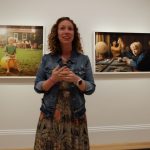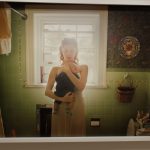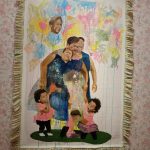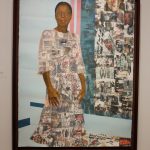By Professor Tiffany Banks On Tuesday, September 30th , students from my COMM 108: Foundations…
(photo above: Amen by Sedrick Huckaby)

Our annual visit to the National Portrait Gallery (NPG) began with Briana Zavadil White, Director of Education and Public Programs, providing the Fellows with an overview of the museum’s mission and history. The mission- to tell the story of America by portraying the people who shape the nation’s history, development and culture -was initially told through traditional portraiture, prints, drawings and engravings. It has expanded to include photography, sculpture, and a variety of digital media such as video art. In fact, photography now represents the largest portion of their collections. No longer guided by the old “decade rule,” which required a person to be dead for ten years before their portrait could be displayed has also allowed for the collections to expand by adding more contemporary works.
Our afternoon was spent focusing on the Kinship exhibit, part of the NPG’s Portraiture Now series which showcases contemporary artists. The current exhibit includes work by eight artists whose work uses portraiture and figurative art as a means to examine the complexities of close interpersonal relationships. Featured are works by Njideka Akunyili Crosby, Ruth Leonela Buentello, Jess T. Dugan, LaToya Ruby Frazier, Jessica Todd Harper, Thomas Holton, Sedrick Huckaby, and Anna Tsouhlarakis,.
Prior to viewing the exhibit, the group began by examining their own ideas of what kinship means and the role it can have in someone’s life. Fellows were then given time to experience the exhibit independently while considering two questions as they viewed each artist’s work: how does each of these artists think about kinship? What resonates with you and why? This rich exhibit prompted much thinking and as Briana later guided us in a deeper consideration of several of the artists and the ways in which each of their works tell a story it was evident that these stories were affected by memories that connect generations both present and past.

Fellows quickly realized how various aspects of each work informed understanding. Elements such as pose, expression, hair styles, clothing, colors, setting, objects in the work, artistic style and scale each contributed to our reaction and connection to the work and to the story suggested to us. Each artist’s statement provided a glimpse into their intent and how they viewed the concept of kinship and the relationships that were important in their own lives. The stories we “saw” were also informed by our own personal experiences, demonstrating how experience and culture will enter a narrative and play a role in what we see and how we interpret what we are seeing. This allows each work to have both a universal and personal meaning. Fellows also were able to see the many ways this exhibit could be used with their own students. across a variety of disciplines.
Before leaving, each of the group was delighted to receive a copy of the companion book for the Kinship exhibit. This was a lovely surprise ending to a wonderful afternoon.










This Post Has 0 Comments